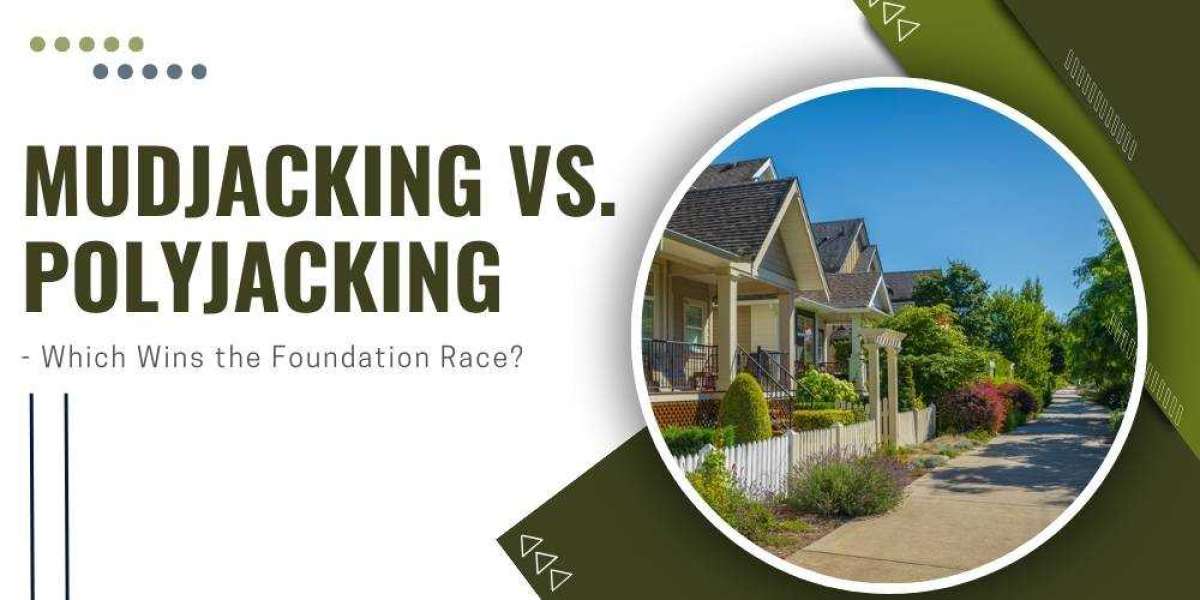Need help with crumbling foundations and know which method to turn to for repairs? A sturdy foundation's importance is undeniable—the bedrock keeps your property upright and secure.
Meanwhile, the foundation repair industry offers two leading players—mudjacking and polyjacking. Each method boasts unique benefits, providing tailored solutions for various situations. In this exploration, we'll dissect these techniques, arming you with the knowledge to decide your needs.
The Challenge of Foundation Settlement
Like an iceberg, foundation settlement signals more serious unseen issues below. It's not just a structural hazard but a safety concern that necessitates a carefully chosen and effective repair method:
· Foundation settlement signifies more profound, hidden problems.
· Initial signs like wall cracks can escalate to severe structural damage.
· Safety concerns demand prompt, effective repair methods.
· Choosing a repair method is a crucial task that requires careful consideration.
Mudjacking: The Traditional Approach
Mudjacking, an age-old solution, has been a staple in foundation repair. It uses a simple technique of injecting a concoction of mud and additives beneath the foundation, pushing it upwards to level it. Despite certain advantages, it poses some concerns, too:
· Mudjacking has been a traditional method of foundation repair.
· It injects mud and additives under the foundation to level it.
· While it offers stability, it has limitations in lifting capability.
· The method brings a risk of soil contamination.
Polyjacking: The Modern Alternative
In contrast, foundation repair has welcomed a modern alternative—polyjacking. It harnesses the power of expanding polyurethane foam to uplift and stabilize unstable foundations. Beyond being innovative, it offers several benefits that balance precision and minimal disruption.
· Polyjacking is a modern, innovative alternative to foundation repair.
· It utilizes expanding polyurethane foam for lifting and stabilizing foundations.
· The method stands out for its balance between accuracy and minimal disruption.
Comparing Mudjacking and Polyjacking
Comparing mudjacking and polyjacking reveals that these two approaches have unique aspects, each with its benefits and qualities. By making a detailed comparison, homeowners can better understand which method fits their situation:
a. Mudjacking Advantages and Disadvantages
Advantages:
· Cost-effectiveness: Mudjacking is usually less expensive than polyjacking, making it a more accessible option for some homeowners.
· Experience: Since mudjacking has been around longer, professionals have more experience working with this method and may prefer it in specific scenarios.
Disadvantages:
· Limited lifting capability: Mudjacking may need to be more precise and have a limited capacity for lifting the foundation compared to polyjacking.
· Risk of soil contamination: As mudjacking utilizes a slurry of cement and soil, there could be soil and water contamination.
b. Polyjacking Advantages and Disadvantages
Advantages:
· Precision: Expanding polyurethane foam in polyjacking allows for a more controlled and accurate lifting process.
· Durability: The foam's resistance to moisture and lasting structural integrity make polyjacking a durable and long-term solution.
· Eco-consciousness: Polyjacking is eco-friendly, as the polyurethane foam is non-toxic and minimally invasive to the environment.
Disadvantages:
· Cost: Polyjacking can be more expensive than mudjacking due to the materials and specialized equipment needed.
· Dependency on contractor: The success of polyjacking largely depends on the experience and expertise of the contractor.
Precision and Efficiency
At its core, polyjacking defines precision and efficiency. It's the reigning champion for fine-tuning foundation repairs using a measured and controlled method. A meticulous regulation of lifting speed made possible through the expanding polyurethane foam ensures a slow, steady, and precise rise to achieve the perfect leveling. This step-by-step process makes polyjacking a reliable option for adjusting and setting foundations right.
Moreover, the strategic process of polyjacking integrates with your daily routine, causing minimal disruptions. It sets a remarkable precedent in creating efficient solutions that don't disturb the regular rhythm of our lives—an indication of its thoughtfully designed system. With lower impacts and increased convenience, polyjacking demonstrates it's more than just another drop in the ocean of foundation repair methods.
Durability and Longevity
Polyjacking undoubtedly excels in the long-distance race of durability and longevity. Its impressive attribute of maintaining the structural integrity of your foundation is no casual claim. Polyjacking leverages the resilience and durability of polyurethane foam, showcasing commendable moisture resistance. This quality ensures added longevity to the foundation repair and keeps the foundation robust for a prolonged period.
The benefits don't just stop at a long-lasting solution; polyjacking also emerges as an affordable option. The process yields dual benefits—a robust, easy solution for the pocket. It aligns with the goal of most homeowners seeking a durable and cost-efficient method for their foundation repair.
Eco-Friendly Considerations
The environmental impact of mudjacking vs. polyjacking intensifies the debate between the two methods. Polyjacking emerges as the eco-friendly choice, offering more than just foundation repairs through sustainable practices to consider:
· Polyjacking promotes sustainability in its application.
· It uses non-toxic materials and a minimally invasive method, protecting the environment.
· The technique contrasts with traditional practices that may pose environmental risks.
· In our environmentally conscious era, polyjacking's eco-friendliness provides a significant advantage.
Choosing the Right Method
Choosing between mudjacking vs. polyjacking in Eastern Kansas for foundation repair goes beyond comparison. It necessitates thoroughly analyzing the factors below:
· Decisions should consider foundation settlement severity, budget, and expected outcomes.
· Decision-making can be overwhelming in this context.
· Seeking professional advice can be beneficial.
· Experts can guide a suitable choice based on their industry experience and knowledge.
Optimal Results: Mudjacking or Polyjacking?
The choice between mudjacking and polyjacking lies in your specific foundation repair needs, environmental concerns, and desired outcomes. Both methods have shown their worth, but polyjacking's precision, efficiency, and eco-friendliness make it an increasingly popular option for property owners.
So, as you weigh your options, which method best aligns with your values, delivers optimal results, and leaves you with a sturdier, more sustainable foundation for years to come? The decision is yours—choose wisely, for it's not just about fixing foundations but building a solid legacy.
References:
· Rasheed, H. (2007). International Journal of Structural Stability and Dynamics: ForWord. ResearchGate. https://www.researchgate.net/publication/289112706_International_Journal_of_Structural_Stability_and_Dynamics_Forword
· Tripp, C. (2023, January 9). Mud Jacking vs Polyjacking Concrete Repair (Cost, Material, Features). Anchor Foundation Repair. https://anchorfoundationrepair.net/blog/cost-of-concrete-repair-mudjacking-vs-polyjacking/
· Nikodym, J. (2023, October 27). Main Differences in Mudjacking vs. Polyjacking. PolyMagic Kansas City, Columbia, and Jefferson City - Concrete Lifting Experts. https://www.polymagic.net/main-differences-in-mudjacking-vs-polyjacking/













